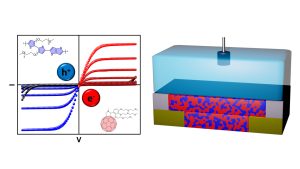A Bridge between Biology & Electronics
Technion researchers develop advanced devices that translate biological signals into electronic ones and vice versa
Researchers at the Technion – Israel Institute of Technology have developed devices that connect electronics with biology and are suitable for monitoring various ions in a solution, sensing in biological systems, and other applications.
The research was headed by doctoral student Eyal Stein and Professor Gitti Frey from the Technion’s Faculty of Materials Science and Engineering along with colleagues from the Wolfson Faculty of Chemical Engineering at the Technion, the University of Oxford in the U.K., and the King Abdullah University of Science and Technology in Saudi Arabia. The article was published in Nature Communications.
In this study, Technion scientists established a toolbox for creating organic electrochemical transistors (OECTs), which are used in a wide variety of applications including those that require adapting to bio-compatible tissue. These components translate ionic signals in an aqueous solution to electric signals, and as such they are particularly well suited for applications involving the interface between biology and electronics. “The device is based on the coupling of ions from a physiological solution with charges in the transistor’s semiconductor channel, and therefore the biological single, expressed by the ions, is translated and amplified into detectable electronic signals. This translation between biological and electric signals is vital for developing innovative medical devices,” explained Prof. Frey.
The novelty of the research lies in the creation of an ambipolar device – one that is able to translate both negative and positive ionic signals by blending two organic semiconductors that have opposite polarities (a polythiophene and a fullerene derivative). This combination ensures that the device has a great deal of versatility and enhanced capabilities compared to existing materials. The study showed that both components are active from an optical, electrochemical, and electric perspective, and at the same time do not disturb each other’s performance. The uniformity of the active layer and the electric stability are a result of the layer’s tailored structure and morphology at a nanometric level.
The new technology is likely to accelerate the development and creation of integrated circuits based on ambipolar OECTs for biological applications. The researchers predict this current achievement will pave the way for designing and creating a new generation of bioelectronics that will be compact, flexible, and simple to produce. This technology can be utilized, for example, for the immediate diagnosis of various physiological conditions, brain activity, and other uses based on changes in the body’s liquids and soft tissue.

Diagram of an ambipolar device (right) and graph depicting its capabilities in positive and negative charges (left) with the molecules used in the research.
For the full paper: https://www.nature.com/articles/s41467-022-33264-2
The research was supported by the European Union (Horizon 2020 grant)



